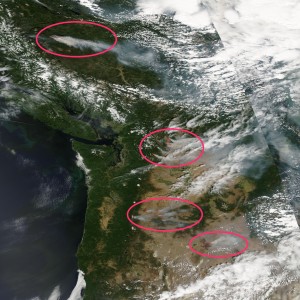
Wildfires – Global Warming / Climate Change is a top topic during the summer of 2015. Wildfires from global warming and climate change are a microcosm of the Wild West. The age of horse-driven highway bandits may be over but wildfires still strike spontaneously, take entire houses full of possessions and sometimes even lives.
Since 1986, wildfires in the western United States have quadrupled, last five times as long and are six times as expansive as the prior seventeen years. The region’s wildfire season has expanded by 64% (78 days.)
An annual average of $665 million in property damage was accrued between 2000-2009, largely due to new construction within danger zones. Homeowners in California’s Wildland Urban Interface (the Bay Area, north of Sacramento and the southern coastal region) are at a growing risk. Putting additional homes in the path of greatest danger wears thin existing firefighting resources, which have become almost twice as expensive this millennium: sometimes over $ 1 billion.
Many argue that some preventative efforts can actually make things worse. The techniques used to suppress fires counterintuitively often burn extra fractions of forests. Trees typically live through several forest fires of various sizes. Minor fires can clear underbrush and deadfall and, over time, improve the overall health of a forest. Some suggest forests should simply be allowed to burn, within reason, to temporarily remove future threats with nature’s prescription instead of protecting them until they’ve grown into larger threats that burn hotter and can kill the more developed trees. Babying a forest too much can also hurt wildlife. The endangered spotted owl, for example, specifically dwells in forests that have recently endured low-intensity fires.
Historically, firefighters’ budgets went largely to preventative efforts but most have shifted toward the typically more costly alternative of addressing existing emergencies. More funds may be required to bring the threat level back down to pre-1986 numbers but a calmer approach may reduce future fires.
Counteractively, nature has ways of aiding wildfires. Droughts are typically the most prominent factor determining their intensity. Lightning is their leading natural cause. Diseases and insect infestations can kill and thus dry out vast counts of trees.
In recent years, warm and dry conditions have aided wildfires by drying the soil of the western United States, particularly California. This year, the pattern shifted northward into Washington. A lack of winter snowfall, a warm spring and an early melting of the snowpack all worsened conditions. The transient climate change similarly affects many aspects of the biosphere, which together can make minor temperature changes appear more directly devastating.
It is immensely important to note that the climate change that’s increasing wildfires in the west is due to regional climate change. The global temperature data tells a different story. Earth’s average recorded temperature peaked in the spring of 1998 during the Great El Nino. A smaller peak was recorded in the summer of 2010. Since the spring of 2012, the global temperature has declined.
It is important to put some perspective on this. There hasn’t been a full degree Celsius of warming since around 1880 when global temperature data recording began. An historic lack of weather stations may be partially to blame for the oldest, coldest observations. In addition, most of the newer sensors have been installed in urban centers, which are increasingly warmer than the rural vast majority of the globe and thus fail to well represent our planet’s actual temperature. Global temperature data has drastically improved since the beginning of the use of weather instruments on satellites in 1967. There are also existent debates regarding the impact of sunspots on the climate and the accuracy of the present considerations regarding carbon dioxide’s relationship with temperature. Bottom line, this is a very complex process.
The debate on global warming will continue regarding its impact on wildfires but there is no debate about the dramatic increase in wildfires and it appears this trend will continue, especially in the Western US.
Article written by Meteorologist Geoff Linsley